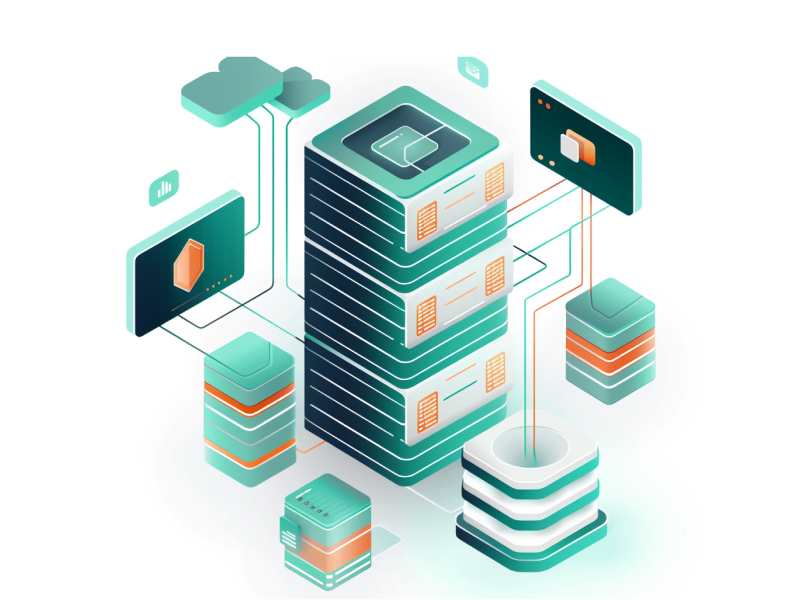Choosing the right database for your application is a decision that can significantly impact its performance, scalability, and cost-efficiency. For a C-suite executive, understanding the various factors involved in this decision-making process is key.
Key questions to guide database selection
The selection of a database should be guided by a series of critical questions. These questions help clarify your application’s requirements and align them with the capabilities of different database solutions.
Expected data storage
For applications expected to store data in gigabytes or less, the choice of database is relatively straightforward. In this scale, almost any database system will suffice, and in-memory databases become a viable option.
In-memory databases offer rapid data access and processing speeds, making them ideal for applications where performance is a key consideration and the data set is small enough to fit into memory.
When dealing with data storage in the terabyte range, multiple database options are available, including both SQL and NoSQL solutions. These databases need to manage significantly larger volumes of data efficiently.
Traditional SQL databases like PostgreSQL and MySQL can handle terabyte-scale data with appropriate indexing and optimization. NoSQL databases like MongoDB and Cassandra also come into play, offering flexible schema designs and horizontal scalability, which are advantageous for handling large and variable data sets.
Storing data at the petabyte scale or beyond presents unique challenges and significantly narrows the list of viable database choices. At this level, significant storage costs are involved, and the need for tiered storage solutions becomes apparent.
Systems like Google Cloud Spanner, Amazon Redshift, and Hadoop HDFS are designed to handle vast amounts of data efficiently.
Systems like these often involve tiered storage strategies, where frequently accessed “hot” data is stored in faster, more expensive mediums like SSDs, while “cold” data resides in slower, cheaper storage like spinning disks, optimizing both performance and cost-efficiency.
Simultaneous user load
Estimating the load from simultaneous users is crucial for performance planning. For internal databases used by employees, this estimation is relatively straightforward. However, public-facing databases must account for potentially unpredictable or seasonal spikes in usage. Scalability, both vertical and horizontal, is a key consideration.
Vertical scaling involves adding more power to a single server, while horizontal scaling involves adding more servers to handle the load. Databases like Amazon Aurora and Google Cloud Spanner offer automated scaling features that can adjust resources based on current demand, ensuring consistent performance.
Overcoming the user load barrier
One significant limitation in handling simultaneous queries is index contention, especially in read/write transactional SQL databases. Index contention occurs when multiple queries compete for the same index resources, leading to performance bottlenecks.
Mitigation strategies include using database sharding, where large tables are split across multiple servers, and employing a combination of OLTP (Online Transaction Processing) and OLAP (Online Analytical Processing) databases to separate transactional and analytical workloads. This approach can balance the load and enhance overall system performance.
‘Ility’ requirements
- Achieving 24/7 database uptime: Availability is paramount for transactional databases, especially for mission-critical applications requiring near-constant uptime. Achieving 99.999% uptime, often referred to as “five nines,” is possible with cloud databases operating across multiple availability zones.
- Scaling your database: Scalability makes sure that your database can grow with your business. Cloud environments simplify dynamic scalability, allowing resources to be added or removed based on demand. Solutions like Amazon DynamoDB and Google Cloud Firestore provide seamless horizontal scaling, making them suitable for applications with fluctuating workloads.
- Keeping response times lightning fast: Latency, the delay before a transfer of data begins following an instruction, is a key metric. For user-facing applications, this requirement often translates to database response times of under 100 milliseconds for simple transactions. Strategies to achieve low latency include using in-memory databases, optimizing query performance, and ensuring efficient indexing. Complex queries can be offloaded to background processes to maintain a responsive user experience.
- Maximizing transactions per second: Throughput, typically measured in transactions per second (TPS), indicates the database’s capacity to handle concurrent operations. High throughput is essential for OLTP databases, which support numerous simultaneous users performing transactions.
- Data consistency every time: Data consistency is a key consideration, especially for applications that require reliable and accurate data at all times. Eventual consistency can improve performance and scalability but may result in stale reads temporarily. The choice between SQL and NoSQL depends on the consistency requirements of your application and the acceptable trade-offs between consistency, availability, and partition tolerance.
Stability of database schemas
For applications with stable, well-defined schemas, SQL databases are typically the best choice. SQL databases enforce a consistent structure, meaning that all data adheres to a predefined format.
This stability is beneficial for applications where data integrity and type consistency are paramount, such as financial systems and enterprise resource planning (ERP) solutions.
NoSQL databases offer greater flexibility for applications with dynamic or evolving data schemas. NoSQL databases, such as MongoDB and Couchbase, allow for schema-less data storage, meaning that different records can have varying structures.
Geographic distribution of users
When your application has a global user base, minimizing latency is crucial to providing a responsive user experience.
The speed of light imposes a fundamental limit on data transfer speeds over long distances, so strategic placement of servers is necessary. Distributed databases can help by positioning data closer to users.
Solutions like Amazon Aurora Global Database and Azure Cosmos DB offer multi-region deployments, ensuring that data is replicated and available in multiple locations worldwide.
Distributed databases use different replication methods to maintain data across multiple locations. NoSQL databases often use peer-to-peer replication, allowing for eventual consistency and faster write operations across distributed nodes.
SQL databases employ consensus algorithms like Paxos or Raft to achieve strong consistency in a distributed environment. Algorithms like these make sure that data remains consistent across nodes, even in the face of network partitions or server failures, making them suitable for applications requiring reliable and consistent data globally.
Natural shape of data
SQL databases store data in structured, rectangular tables with predefined columns and data types.
A structured format is ideal for applications requiring strong data integrity and complex queries, such as relational data models used in traditional business applications. SQL databases like MySQL and PostgreSQL offer comprehensive querying capabilities through SQL, supporting JOIN operations to relate data across multiple tables.
Document databases store data in JSON-like formats, allowing for nested documents and arrays. A flexible schema design accommodates varied and evolving data structures, making document databases like MongoDB and Couchbase suitable for applications with diverse and dynamic data, such as content management systems and eCommerce platforms.
The ability to store complex data structures natively simplifies data handling and retrieval.
NoSQL databases encompass a variety of storage models, including key-value stores and columnar stores.
Key-value stores, such as Redis and DynamoDB, provide high-speed data retrieval using a simple key-based lookup. Columnar stores, like Apache Cassandra and HBase, excel in handling wide tables with large numbers of columns, making them suitable for time-series data and analytical applications.
OLTP, OLAP, or HTAP?
OLTP databases are designed for high-speed transactional processing, handling numerous short, online transactions as they prioritize fast writes and minimal indexes to give quick data insertion and retrieval. Databases like MySQL, PostgreSQL, and SQL Server are commonly used for OLTP applications, supporting tasks such as order processing, payment transactions, and inventory management.
OLAP databases focus on analytical processing, enabling complex queries and data analysis as they are optimized for read-heavy operations, with extensive indexing to support fast data retrieval. OLAP databases like Amazon Redshift, Google BigQuery, and Microsoft Azure Synapse Analytics are used for business intelligence, data warehousing, and reporting.
HTAP databases combine the capabilities of OLTP and OLAP, supporting both transactional and analytical workloads. They often use replication to separate transactional data from analytical queries, ensuring that both types of operations are efficient. Solutions like Google Cloud Spanner and Azure Cosmos DB provide HTAP functionality, facilitating real-time analytics on live transactional data without compromising performance.
Read/write ratio
Databases optimized for read-heavy workloads typically use B-trees for indexing, which provide efficient data retrieval for read operations.
Read-heavy applications, such as content delivery networks and news websites, benefit from databases like Elasticsearch and Solr, which are designed for fast, complex searches and high read throughput.
Write-heavy applications, such as logging systems and IoT data collection, require databases that can handle frequent and high-volume data writes.
Log-structured merge-trees (LSM trees) are often used in these scenarios to optimize write performance. Databases like Cassandra and RocksDB are well-suited for write-heavy workloads, ensuring that data is written efficiently while maintaining good read performance.
Geospatial indexes and queries
Efficient querying of geographic or geometric data requires specific types of indexes to handle the unique challenges posed by spatial data.
R-trees, for instance, are a common choice due to their ability to efficiently index multi-dimensional information. This type of index is essential for applications that need to perform operations such as finding all objects within a certain radius or determining which objects fall within a specified boundary.
For example, a logistics company might use a geospatial database to manage and optimize delivery routes. When using R-trees, the system can quickly identify the nearest delivery points to a specific location, improving efficiency and reducing fuel costs.
Geospatial indexing is key for applications like geographic information systems (GIS), location-based services, and urban planning.
In addition to R-trees, there are other data structures like Quadtrees, KD-trees, and GeoHashes that can be used depending on the specific requirements and the nature of the spatial queries.
Choosing the right index structure is critical for achieving fast query performance and handling large datasets effectively.
Full-text indexes and queries
Full-text search requires a different approach to indexing compared to relational or geospatial data.
Inverted list indexes, which store a mapping from content, such as words or terms, to their locations in a database, are commonly used, significantly speeding up search queries by avoiding the need to scan the entire database.
Usage of full-text search is widespread in applications such as document management systems, email search, and social media platforms. Implementing inverted list indexes involves processing the text to create tokens, handling stop words, and stemming words to their base forms to improve search accuracy and efficiency.
Preferred programming languages
The choice of database can be influenced by the programming languages preferred in your application environment.
JSON (JavaScript Object Notation) is a natural data format for JavaScript applications, making databases that support JSON data types, such as MongoDB, Couchbase, or PostgreSQL, particularly attractive for developers working in JavaScript.
Compatibility between the database and the programming language can streamline development processes, reduce the need for complex data transformations, and enhance overall productivity.
In environments where strongly-typed programming languages like Java or C# are used, choosing a strongly-typed database can provide benefits in terms of type safety and reducing runtime errors. Alignment between the database and programming language ecosystem is a key consideration in the technology stack decision-making process.
Budgetary constraints
Databases vary widely in cost, ranging from free and open-source solutions to expensive enterprise-level systems.
Open-source databases like MySQL, PostgreSQL, and MongoDB offer robust features without licensing fees, making them attractive for startups and small businesses.
Free versions might require internal expertise for management and maintenance.
Paid versions and enterprise offerings often come with additional features, enhanced performance, and professional support. Oracle Database and Microsoft SQL Server offer advanced capabilities and comprehensive support but come with significant licensing costs. Cloud-based databases such as Amazon RDS, Google Cloud SQL, and Azure SQL Database offer pay-as-you-go pricing models, which can be beneficial for scaling costs with usage.
When considering the budget, it’s important to account for both direct costs (licensing and support fees) and indirect costs (maintenance, scaling, and potential downtime). Balancing these factors helps in selecting a database that fits the financial constraints while meeting performance and scalability needs.
Support considerations
Open-source databases might lack formal vendor support, which can be a drawback if your team lacks the necessary expertise.
In such cases, relying on community support might not be sufficient for mission-critical applications. Engaging with vendors or cloud providers for support can offload the burden of database administration and maintenance, allowing your team to focus on core business activities.
For instance, enterprise support from vendors like Oracle, Microsoft, or MongoDB Inc. ensures access to expert assistance, timely updates, and performance optimizations. Cloud providers like AWS, Google Cloud, and Azure offer managed database services with varying levels of support and SLA guarantees, providing peace of mind and operational efficiency.
Legal restrictions
Compliance with data security and privacy regulations is non-negotiable.
In the EU, the General Data Protection Regulation (GDPR) imposes strict requirements on data protection, privacy, and the location of data. Non-compliance can result in hefty fines and legal repercussions.
In the US, the Health Insurance Portability and Accountability Act (HIPAA) governs the handling of medical information, while the Gramm-Leach-Bliley Act (GLBA) regulates how financial institutions manage customer data. California’s Consumer Privacy Act (CCPA) enhances privacy rights and consumer protection, requiring businesses to implement stringent data handling practices.
Compliance
Certain databases are designed with built-in features to facilitate compliance with these regulations. Databases that offer encryption, auditing capabilities, and data masking can simplify compliance efforts.
On the other hand, some databases might lack these features, making it challenging to achieve regulatory compliance regardless of how carefully data is managed.
Selecting a database that supports compliance with relevant laws is essential. Features such as role-based access control, encryption at rest and in transit, and comprehensive logging can aid in meeting legal requirements. Evaluating these capabilities during the database selection process helps mitigate legal risks and protects sensitive data.
SQL vs. NoSQL database
For applications that demand low latency, high throughput, and can tolerate eventual consistency, key-value NoSQL databases are an optimal choice.
These databases, such as Redis and Amazon DynamoDB, provide massive horizontal scalability, which is essential for handling large volumes of data and high-velocity transactions.
In scenarios like real-time analytics, session management, and caching, NoSQL databases work well due to their ability to quickly process vast amounts of data and respond to queries in milliseconds. A schema-less design offers flexibility, allowing for rapid development and iteration.
For applications involving financial transactions, where atomicity, consistency, isolation, and durability (ACID) properties are paramount, SQL databases are the preferred solution.
Distributed SQL databases like Google Cloud Spanner or CockroachDB provide the necessary guarantees for reliable, accurate transactions, even across geographically dispersed regions.
SQL databases support complex queries, relationships, and data integrity, making them suitable for financial systems, ERP solutions, and other mission-critical applications where data accuracy and consistency cannot be compromised.
Final recommendations
Selecting the right database involves thoroughly answering all the critical questions related to your application’s requirements. A comprehensive evaluation helps avoid the pitfalls of committing to a database that may prove inadequate or excessively costly in the long run.
Considering factors such as data storage needs, user load, ‘ility’ requirements, schema stability, geographic distribution, data shape, read/write ratios, indexing needs, programming language compatibility, budgetary constraints, and legal restrictions ensures that the chosen database aligns well with your business goals and technical requirements.
Understanding data storage expenses
Data storage costs become significant when dealing with petabyte-scale data.
Businesses must weigh the pros and cons of on-premises storage, which involves high capital expenditures, versus cloud storage, which incurs ongoing operational expenses. Cloud providers like AWS, Google Cloud, and Azure offer scalable storage solutions with varying cost structures, allowing businesses to pay for only what they use.
Tackling index contention head-on
Index contention can limit the number of simultaneous queries in read/write transactional databases. This occurs when multiple transactions compete for the same index resources, leading to performance bottlenecks.
Strategies to mitigate this include using sharding techniques to distribute the load and combining OLTP and OLAP databases to separate transactional and analytical workloads.
Meeting the gold standard in latency
Maintaining sub-second response times is ideal for user-facing applications, with database responses under 100 milliseconds for simple transactions being the target. Achieving these latency standards involves optimizing query performance, using in-memory databases, and efficiently indexing data.
Offloading complex queries to background processes can also preserve fast response times for users.
Deciphering data consistency options
Data consistency models range from strong consistency in SQL databases to eventual consistency in NoSQL databases.
Strong consistency ensures that all reads reflect the most recent write, which is essential for applications requiring reliable data accuracy. Eventual consistency can improve performance and scalability but may temporarily result in stale reads. The choice of consistency model should align with the application’s requirements and acceptable trade-offs.





